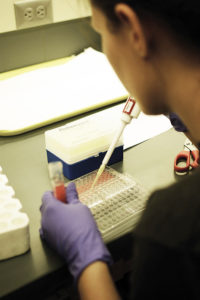Puerarin has potential as aquafeed supplement

In the realm of aquaculture, the loss of productivity through infections and subsequent reductions in growth and development are major problems that require innovative methods for generating solutions. There are no commercially available vaccines against many aquatic pathogens, and further exacerbating the problem, the use of antibiotics for treatment of fish is not preferred due to the risk of developing antibiotic resistance within the bacteria and harming non-target species.
Further complicating the situation is the fact that in aquaculture, fish are raised in tanks with thousands of other fish under crowded conditions, which can negatively affect feeding behavior and other normal physiological functions such as growth, immune response and reproductive prowess.
Stress response
Within the aquaculture industry, the protocols for handling fish are well-documented acute stressors that lead to stress levels which are tolerated despite causing undesirable effects. In fish, stress response is marked by the stimulation of the hypothalamus-pituitary-interrenal axis, which leads to a shift in levels of plasma cortisol and the sympathetic-catecholamine cell axis that elevates catecholamine levels. Cortisol is an immunosuppressive agent, and increased occurrences of disease have been observed in stressed fish.
In addition to a suppressed immune response through cortisol, acute stress has been characterized by hyperglycemia, which has been associated with complications such as strokes in both animal and human models, along with increased susceptibility to infections in fish. Teleost fish have been well-documented for their reduced capacities to clear plasma glucose levels, and hence are more prone to suffer from stress-induced hyperglycemia.
Studying effects

A study was developed to determine the effects of supplementing commercial fish feed with puerarin, the most biologically active isoflavone present in the roots of kudzu, Pueraria lobata, on modulating acute stress within salmonids. Salmonids are known for their upstream migration patterns, which have been reported to induce stress within the fish.
While kudzu powder has been used in Asian countries as a natural treatment for cardiovascular diseases, recent research has shown puerarin to reduce skeletal tissue blood glucose levels in diabetic mice over a period of one day. Moreover, puerarin helped restore GLUT-4 (the primary glucose transporter in skeletal tissue) mRNA expression levels in the diabetic mice to levels similar to those in non-diabetic mice within three days.
Since rainbow trout, Oncorhynchus mykiss, possess GLUT-4 transporter proteins, the authors chose Chinook salmon, O. tshawytscha, which belong to the same genus as rainbow trout and are a farmed species of Pacific salmon, for the study. In addition, Chinook salmon have been shown to elicit very high post-stress plasma cortisol levels, often reaching 400 ng/ml during upstream migration in the wild.
Performing stress response studies under laboratory conditions is difficult, since the fish are typically acquired from hatcheries where fish are reared with thousands of other fish. There- fore, it is harder to induce stress through crowding, as the fish are accustomed to being in close proximity to each other since birth.
Due to their capacity to be stressed, fingerling Chinook salmon provided a good model organism to determine the effects of puerarin on acute stress. Stress was induced through chasing and netting the fish, as those are conditions fish encounter in aquaculture facilities.
Experimental setup
The fingerlings were acquired from the Bodine State Fish Hatchery in Mishawaka, Indiana, USA, transported to the Life Science Resource Center at Purdue University – Fort Wayne campus and allowed to acclimate for two months prior to the start of the study.
The study focused on determining the consequences of puerarin supplementation on acute stress and chronic stress. Acute stress was induced by transferring all the fish randomly from their housing tanks into replicate tanks in which fish were fed a control feed and unstressed, tanks where the fish received puerarin-supplemented feed and were not stressed, tanks whose fish were fed a control diet and stressed, and tanks that received feed with puerarin and stressed the fish.
Five hours post-transfer, the fish were fed their respective feeds to satiation. Subsequently, the stress groups were chased with nets for five minutes. The fish were sampled prior to the initial transfer and then once more 24 hours following the transfer. The experimental conditions were maintained for eight more weeks to mimic chronic stress. The fish were sampled at two-, five- and eight-week intervals for plasma cortisol, blood glucose, hematocrit, plasma protein, spleen somatic indices, respiratory burst and condition factor.
Results
Results from the acute stress phase of the study revealed that the supplementation of puerarin lowered blood glucose levels while improving blood circulation, as the fish had lower levels of glucose, hematocrit and protein when fed feed with puerarin. Analyses for the chronic portion of the study revealed that puerarin helped improve blood circulation due to relatively lower levels of hematocrit and plasma proteins within the stressed groups than the fish given the control diet.
The results from this study were concurrent with prior studies with puerarin on mice. Puerarin in fast-acting and rapidly metabolized by the body, and its anti-hyperglycemic properties were best observed during the acute stress phase of the study. These results agreed with previous research, as puerarin’s anti-hyperglycemic properties were most effective after 24 hours.
Perspectives
The results of this study – one of the first of its kind – illustrated the potential of puerarin supplementation in commercial fish feed. Further studies could test the effects of puerarin on salmonids for a period longer than eight weeks and at different concentrations. In addition, subsequent studies could focus on the financial viability of using kudzu roots to generate puerarin for feed supplementation.
(Editor’s Note: This article was originally published in the November/December 2013 print edition of the Global Aquaculture Advocate.)
Authors
-
Rumman Hossain
Indiana University – Purdue University
Fort Wayne, Indiana, USA
2101 East Coliseum Boulevard
Fort Wayne, Indiana 46835 USA -
Ahmed Mustafa, Ph.D.
Indiana University – Purdue University
2101 East Coliseum Boulevard
Fort Wayne, Indiana 46835 USA
Tagged With
Related Posts

Aquafeeds
A look at phospholipids in aquafeeds
Phospholipids are the major constituents of cell membranes and are vital to the normal function of every cell and organ. The inclusion of phospholipids in aquafeeds ensures increased growth, better survival and stress resistance, and prevention of skeletal deformities of larval and juvenile stages of fish and shellfish species.

Health & Welfare
AHPN inferences based on behavior of vibrio bacteria
Vibrio parahaemolyticus, a strain of which is the cause of acute hepatopancreatic necrosis (AHPN), has both virulent and benign strains. This strain colonizes the stomachs of shrimp by the formation of a biofilm, which protects it from antibiotics and other potential treatments.

Innovation & Investment
AquaBounty, with new RAS facility, hopes to win public support for GM salmon
Ron Stotish, CEO of AquaBounty Technologies, believes genetically modified salmon is no threat to its opponents and the outlook for AquAdvantage is good. With its purchase of the Bell Fish Co. RAS facility, commercialization will soon commence.

Aquafeeds
A new nutrient for aquaculture, from microbes that consume carbon waste
Biotechnology firm NovoNutrients aims to produce a line of nutraceutical aquafeed additives as well as a bulk feed ingredient that can supplement fishmeal. Its process includes feeding carbon dioxide from industrial gas to a “microbial consortium” starring hydrogen-oxidizing bacteria.


